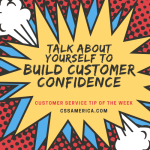 The IT helpdesk representative was on a call with a customer, and in trying to troubleshoot an issue, the employee said, “Let’s start by opening Windows.” The customer said “OK,” and there were 2 minutes of silence. The employee twice asked, “Are you still there?” with no response. Finally, the customer got back on the phone and said, “Sorry about that; two of my windows were easy to open, but the third was painted shut.”
The IT helpdesk representative was on a call with a customer, and in trying to troubleshoot an issue, the employee said, “Let’s start by opening Windows.” The customer said “OK,” and there were 2 minutes of silence. The employee twice asked, “Are you still there?” with no response. Finally, the customer got back on the phone and said, “Sorry about that; two of my windows were easy to open, but the third was painted shut.”
This is a true story, it came out of training we conducted almost 20 years ago, and in many ways it applies today, as well.
Not every customer grew up with technology, and not every customer loves or is naturally wired to work with technology. Especially in this age where so many are working remotely and we have a need to provide customer service remotely, we need to understand if the person we’re talking to is technology-challenged.
These people are as smart or smarter than any of us, but maybe they just have a different communication preference or a different background or a different level of experience and comfort with technology. To address these unique individuals, here are three key areas of focus.
Patience – First, it’s about our way of interacting with people. We need to be very patient and very empathetic/understanding, as well. A little bit of levity and laughter is always good when done appropriately. Keep in mind that we’re trying to create comfort with this person and reduce their anxiety, and the more patient and understanding we are in the words we say and the tone we use, the more comfortable they will become.
Phrases – Second, effective communication in these situations is based on understanding the importance of words. Even “windows” does not mean the same thing to everybody. Try to avoid the acronyms. Try to understand that simplicity is vital. Does “application” mean the same thing to everybody? What does it mean to “click on” something? Think about keeping things Short, Simple, and Summarized, so that they understand. And if you feel they don’t understand, ask them their understanding of what they see, should be seeing, or should be doing.
Process Steps – Third, don’t move through multiple steps quickly. Always end one step by confirming where they are before going on to step two. End each step with a clarification question if there’s any doubt about where they are at that point.
If we want to deliver great customer service, let’s tailor the process of delivering that customer service to the individual we are speaking with at the time.
Let’s provide great customer service in this technology world, particularly to the technology-challenged customer.
Signup for FREE Tips! Contact Us More Resources for You Visit Our Home Page











